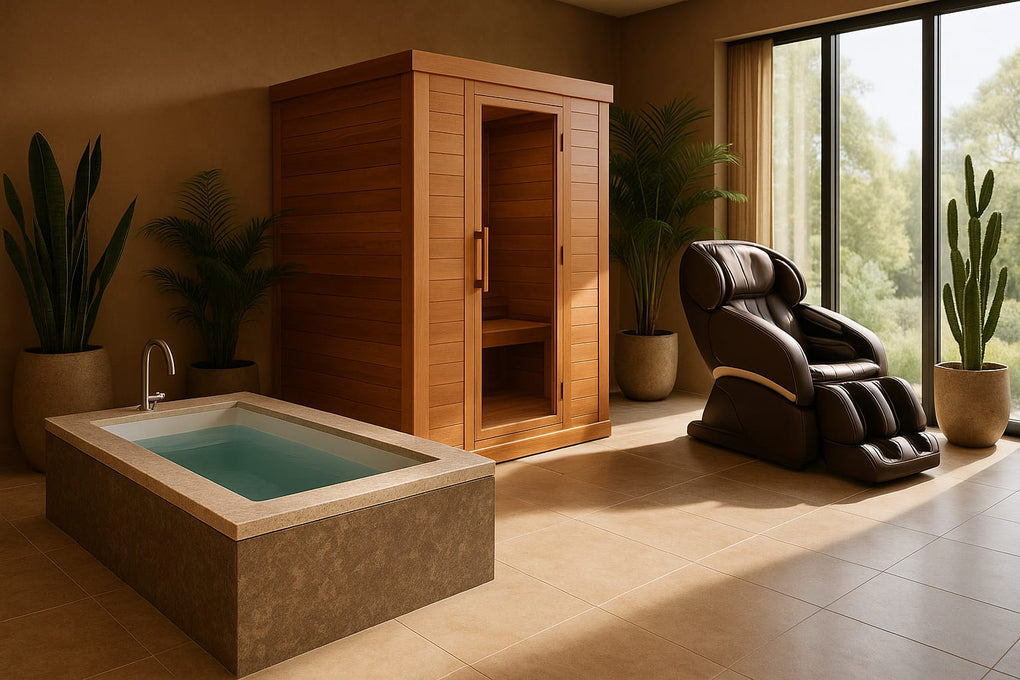Designing Your Dream Home Spa: Layout, Power, and Décor
Introduction
Answering the common question how much does it cost to install a home spa starts with a range. A basic sauna or massage chair room can cost a few thousand dollars. A full indoor spa with hot tub, cold plunge, and custom finishes can reach tens of thousands.
This guide covers infrared saunas, cold plunges, hot tubs, and massage chairs. You will learn layout, power and plumbing, ventilation, permits, cost breakdown, and décor tips.
Start with a Clear Plan and Goals
Define Purpose and Priorities
Decide if the space is for daily use or occasional relaxation. Is it for therapy, sleep support, or entertaining? Your purpose affects size and equipment choices.
Therapy needs often require higher-end controls and dedicated plumbing. Occasional use can mean simpler installs and lower cost. Knowing your priorities limits surprises later.
Choose the Best Location
Indoor locations offer climate control and easier plumbing. Outdoor spots add a backyard retreat feel and can reduce mold risk.
Check structural access. Can the delivery team get a hot tub through your door? Will a crane be needed? Delivery logistics influence final costs.
Spa Room Layout Ideas
Think about flow between features. An open-plan layout encourages socializing. A dedicated room enhances privacy and quiet.
Single-feature layouts keep budget down. Combo setups pair a sauna with a cold plunge or shower. Zoned relaxation areas separate wet and dry zones.
Use simple plans: single feature near a utility wall, combo with a drain and electrical access, or a three-zone plan with entry, wet area, and lounge.
Real Costs: how much does it cost to install a home spa
Typical Price Ranges by Product
Infrared saunas: $1,500 to $8,000 retail. Installed rooms add framing and electrical costs. Cold plunges: $2,000 to $12,000, depending on size and filtration. Hot tubs: $4,000 to $30,000 retail. Installation and decking add thousands. Massage chairs: $1,000 to $8,000.
Low-end totals for a simple sauna room can be $3,000 to $6,000. Mid-range combos with a small hot tub and finishes run $15,000 to $35,000. High-end custom spa rooms can exceed $50,000.
Home Spa Installation Cost Breakdown
Equipment is the biggest line item. Site prep includes demolition, framing, and floor work. Electrical can be costly with dedicated panels and higher amperage.
Plumbing and drains add cost for hot tubs and cold plunges. Finishes, like tile and waterproof paint, vary widely. Labor and permits also matter. Expect 20–40% of equipment cost for professional installation.
Example budgets: Simple sauna room — $2,000 equipment, $1,000 electrical, $1,000 finishes, $1,000 labor and permits = $5,000. Full spa build — $15,000 equipment, $5,000 electrical/plumbing, $10,000 finishes, $5,000 labor/permits = $35,000.
Power, Plumbing, and Structural Needs
Electrical Requirements and Tips
Saunas often require a dedicated 120V or 240V circuit. Infrared models usually run on 120V. Traditional steam saunas and hot tubs often need 240V and 30–60 amps.
Place panels for easy access. Install GFCI protection for water areas. Consider surge protection for electronics. Early coordination with an electrician avoids surprises.
Plumbing, Drainage, and Floor Load
Hot tub drains must handle tens to hundreds of gallons. Plan overflow routes and floor drains. Cold plunge tubs need filtration and condensate management.
Check floor load limits. A filled hot tub can weigh thousands of pounds. Reinforce joists or install on a slab when needed. Subfloor options include concrete pads and engineered decking.
Permits and Code Requirements for Home Spa
Permits are often required for electrical, plumbing, and structural changes. Local codes may also require specific drain sizes and vapor barriers.
When in doubt, contact your building department early. An inspector can outline what triggers a permit. Addressing permits before work saves costly rework and fines.
Ventilation and Moisture Control for Home Spa
Ventilation Strategies
Proper airflow prevents mold and maintains comfort. Mechanical ventilation is reliable. Passive vents work for mild climates but may not be enough.
Use exhaust fans sized for the room. Consider a heat recovery ventilator to save energy. Place inlet and outlet vents to avoid short-circuiting airflow.
Moisture Control and Insulation
Install vapor barriers where needed. Use mold-resistant drywall or cement board in wet zones. Choose paints and sealants rated for high humidity.
Regular maintenance includes checking seals, grout, and exhaust operation. Proper insulation keeps temperatures stable and reduces condensation.
Professional Spa Installer vs DIY
Pros and Cons: Professional Spa Installer vs DIY
Hiring a pro brings code compliance, warranty support, and speed. Professionals reduce risk on electrical and structural work. They cost more upfront.
DIY saves labor costs but increases risk on wiring, plumbing, and permits. DIY suits skilled homeowners on simpler installs. For complex builds, a pro is safer.
How to Find and Vet Installers
Ask for licenses, insurance, and references. Request written quotes with timelines and payment schedules. Confirm permit handling and inspection coordination.
Red flags include vague quotes, no references, and pressure to pay large sums upfront. Include warranty details and change-order rules in the contract.
Design, Finishes, and Décor for a Luxury Feel
Materials and Finishes That Perform
Choose water-resistant flooring like porcelain tile or sealed stone. Use mold-resistant wall finishes in wet zones. Opt for durable, easy-clean materials.
Lighting fixtures should be rated for damp or wet locations. Select finishes that age well and are simple to maintain.
Lighting, Sound, and Ambiance
Layer your lighting with tasks, accents, and mood lights. Dimmable LEDs and color control add drama. Place lights to avoid glare on wet surfaces.
Soundproofing and quality speakers enhance relaxation. Use concealed wiring and smart controls for a clean look.
Furnishings and Layout Flow
Include seating, towel storage, and reachable controls. Keep circulation clear between wet and dry areas. Small touches like heated towel rails and plants elevate the experience.
Timeline, Budget Checklist, and Final Steps
Typical Project Timeline
Planning and permits: 2–8 weeks. Rough-in electrical and plumbing: 1–2 weeks. Finishes and equipment install: 1–3 weeks. Final inspection: a few days to two weeks.
Simple projects can finish in a month. Complex builds with structural work may take several months.
Budget Checklist and Contingency Planning
Include equipment, delivery, site prep, trades, finishes, permits, and inspections. Add a contingency of 10–20% for unknowns.
If budget is tight, prioritize electrical, ventilation, and waterproofing. Delay nonessential finishes until later.
Conclusion
So, how much does it cost to install a home spa? Expect a range from a few thousand for a basic sauna or chair room to tens of thousands for a full custom spa. The big drivers are equipment, electrical and plumbing, ventilation, structural work, and finishes.
Next steps: finalize goals, sketch a layout, get 2–3 quotes, and check local permits. Plan ventilation and power early. If you need products and veteran-owned service, visit My Luxury Home Spa for infrared saunas, cold plunges, hot tubs, and massage chairs with free U.S. shipping to help create your dream spa today.







Leave a comment